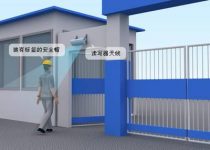
RFID technology invades construction sites, making personnel management more intelligent
[ad_1]
RFID has the advantages of fast scanning, small size, reusable, penetrating and barrier-free reading, large data memory capacity, anti-pollution ability and strong durability, and other environmental adaptability advantages, which enable it to develop and popularize rapidly.
By arranging corresponding readers and locators in the area, the location of the reader or locator is used to determine the area where the identification card is located, and the personnel’s location monitoring is realized, and the location accuracy can reach 2 meters. At the same time, the use of vehicle guidance systems, access control management systems, etc., can achieve a variety of intelligent management and monitoring, so as to achieve comprehensive intelligent management of personnel.
The RFID technology positioning management system has functions such as automatic entry of visitor information, ID card anti-counterfeiting, intelligent management of visit information, and real-time confirmation of visit process; it can also establish visitor information database, set visitor black and white lists, count the number of visits, etc. Function to improve the efficiency of visitor management. At the same time, the use of advanced Internet of Things technology can carry out indoor and outdoor positioning and tracking, regional control and other supervision of visitors to improve the management level.

Area control
For specific security, secret-related or other important areas, intelligent identification and control are realized by authorized configuration of designated personnel. Construction site personnel can only enter the authorized area, and visitors can only enter the reserved area, and access is restricted. The personnel in the area can be reminded in real time.
Illegal alarm
For people who enter illegally, such as visitors passing through the entrance and exit without authorization, the system can identify and alarm. In addition, the system can flexibly set a variety of alarms according to the actual situation, such as access overtime alarms.
Track playback
The system can query and replay the personnel’s historical track, historical data report, etc. Through the electronic map, the historical trajectory of a designated person in a certain period of time can be played back in the form of animation, and other specific information can be displayed with a chart.
Specify a worker, a certain time period (start time and end time), the system will display the detailed location information of the worker at each moment in the form of a data list. At the same time, the historical trajectory of the construction site can be played back in the form of animation on the map, and the user can control the playback speed of the trajectory.
Real-time statistics
The system supports real-time statistics on the number of employees’ daily attendance, number of visitors, number of interviewees, number of people staying in the area and other information in real-time by region or building. Such as real-time query of the number of visitors on a certain floor, the number of visitors stranded in a certain area, and the current number of visitors, etc. At the same time, the system has a query function, which can query personnel information and interviewed personnel information by region.
Video linkage
The video linkage function binds the base station to the video surveillance equipment. When an alarm occurs, the system will promptly call the video surveillance equipment to the place where the incident occurred and record the video information of the alarm location, and vice versa, that is, when the surveillance equipment finds suspicious in the surveillance area When a situation occurs, the system will promptly call the intelligent management system to perform positioning, analysis, and recording of personnel in the monitoring area.
The Internet of Things technology is developing rapidly under the vigorous promotion of the country, and has been applied in all walks of life. Smart construction sites have been widely used in recent years. The combination of Internet of Things technology and RFID will definitely accelerate the development of smart construction sites and also promote the advancement of the Internet of Things technology itself.
[ad_2]


